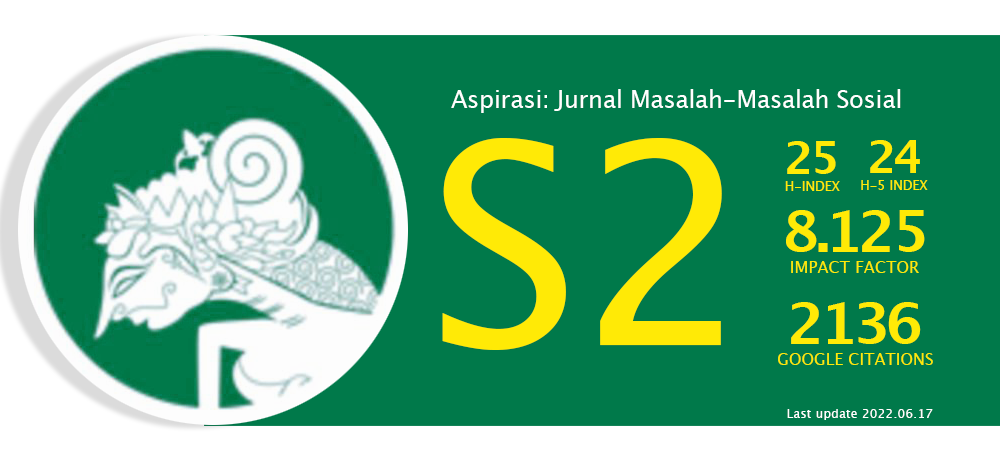The Factors Correlate to Family Size in Indonesia
Abstract
Some tribes in Indonesia have a big family culture. The study aimed to analyze factors that correlate to family size in Indonesia. The study employed secondary data from the 2017 Indonesia’s Demographic and Health Survey. The samples used were 34,353 childbearing age couples. The variables analyzed included type of residence, wealth, marital, cohabitation duration, complete child gender, contraceptive, age of husband-wife, education of husband-wife, and occupation of husband-wife. Final test by binary logistic regression. The results show that couples in urban areas are less likely to have a family size ≤ 4 than couples who live in rural areas. The better the wealth status, the higher the possibility to have a family size ≤ 4. The longer the cohabitation period, the lower the possibility of having a family size ≤ 4. Couples who already have complete child gender were 0.148 times more likely to have a family size < 4 than couples with incomplete child gender. The contraceptives use has a probability of 0.727 times more than those not using it to have a family size ≤ 4. The husband with primary education was 1.242 times more likely than the husband with no education to have a family size ≤ 4. The study found that a wife’s age correlated to family size. Couples with employed wives were 1.273 times more likely than those not employed to have a family size ≤ 4. The study concluded that eight variables correlated to family size among childbearing age couples in Indonesia: residence, wealth, cohabitation duration, complete child gender, contraceptive use, husband’s education, wife’s age, and wife’s employment.
Abstrak
Beberapa suku di Indonesia memiliki budaya keluarga besar yang sangat kuat. Penelitian ini bertujuan untuk menganalisis faktor-faktor yang berkorelasi dengan ukuran keluarga di Indonesia. Studi memanfaatkan data sekunder dari Survei Demografi dan Kesehatan Indonesia tahun 2017. Sampel yang digunakan adalah 34.353 pasangan usia subur. Variabel yang dianalisis meliputi jenis tempat tinggal, kekayaan, perkawinan, lama kohabitasi, kelengkapan jenis kelamin anak, kontrasepsi, umur suami-istri, pendidikan suami-istri, dan pekerjaan suami-istri. Pengujian akhir dengan regresi logistik biner. Hasilnya menunjukkan pasangan di daerah perkotaan lebih kecil kemungkinannya untuk memiliki ukuran keluarga ≤ 4 dibandingkan pasangan yang tinggal di daerah pedesaan. Semakin baik status kekayaannya maka semakin tinggi kemungkinan memiliki ukuran keluarga ≤ 4. Semakin lama kohabitasi maka semakin kecil kemungkinan memiliki ukuran keluarga ≤ 4. Pasangan yang sudah memiliki jenis kelamin anak lengkap kemungkinannya 0,148 kali dibandingkan dengan yang tidak lengkap untuk memiliki ukuran keluarga ≤ 4. Pemakaian alat kontrasepsi memiliki probabilitas 0,727 kali lipat dibandingkan dengan yang tidak menggunakannya untuk memiliki ukuran keluarga ≤ 4. Suami yang berpendidikan dasar 1,242 kali lebih mungkin untuk memiliki ukuran keluarga ≤ 4 dibanding keluarga dengan suami tidak berpendidikan. Usia istri menjadi faktor penentu ukuran keluarga. Pasangan dengan istri yang bekerja 1,273 kali lebih mungkin dibandingkan mereka yang tidak bekerja untuk memiliki ukuran keluarga ≤ 4. Hasil penelitian menyimpulkan bahwa delapan variabel merupakan faktor-faktor yang memengaruhi ukuran keluarga pada pasangan usia subur di Indonesia. Delapan faktor tersebut adalah jenis tempat tinggal, status kekayaan, lama kohabitasi, jenis kelamin anak lengkap, penggunaan kontrasepsi, pendidikan suami, usia istri, dan status pekerjaan istri.
Keywords
Full Text:
pdfReferences
Afidah, N. N. (2020). Kampung keluarga berencana sebagai upaya mengubah paradigma mitos banyak anak banyak rezeki. Prosiding Seminar Nasional Bahasa
dan Sastra Indonesia Sasindo Unpam2019, Pamulang, Universitas Pamulang, 1(2), 94–108. Diakses dari http://www.openjournal.unpam.ac.id/index.php/Proceedings/article/view/4062
Al-Shahomee, A. A., & Lynn, R. (2018). Intelligence and family size in Libya. The Mankind Quarterly, 59(2), 255–265.
Araban, M., Karimy, M., Armoon, B., & Zamani-Alavijeh, F. (2020). Factors related to
childbearing intentions among women: A cross-sectional study in health centers, Saveh, Iran. Journal of the Egyptian Public Health Association, 95(1), 1–8. doi: 10.1186/s42506-020-0035-4
Ariho, P., & Kabagenyi, A. (2020). Age at first marriage, age at first sex, family size
preferences, contraception and change infertility among women in Uganda: Analysis of the 2006-2016 period. BMC Women’s Health, 20(1), Article number 8. doi: 10.1186/s12905-020-0881-4
Arthur, J. L. (2005). Family size and its socio-economic implications in the Sunyani Municipality of the Brong Ahafo Region of Ghana, West Africa. Ghana: Centre for Development Studies, Faculty of Social Science, University of Cape Coast. Unpublish. Diakses dari http://www.ciesin.org/documents/arthurjl.pdf
Bagheri, A., & Saadati, M. (2018). Value of children: attitudinal factors influencing childbearing desire of Iranian women.Women’s Health Bulletin, 5(4), 1–6. Doi: 10.5812/whb.79370
Badan Kependudukan dan Keluarga Berencana Nasional [BKKBN]. (2018, Januari 30). Deputi KBKR: angka fertilitas wanita Indonesia alami penurunan. Diakses dari https://www.bkkbn.go.id/detailpost/deputi-kbkr-angka-fertilitas-wanita-indonesia-alami-penurunan
Chen, C., Zhao, W., Chou, S. Y., & Lien, H. M. (2021). The effect of family size on parents' labor supply and occupational prestige: Evidence from Taiwan and Mainland China. China Economic Review, 66, 101596.
Chen, Q. (2017). Relaxed population policy, family size, and parental investments in children’s education in rural Northwestern China. International Journal of Educational Development, 54, 39–50. doi: 10.1016/j.ijedudev.2017.03.009
Chen, Q. (2021). Population policy, family size and child malnutrition in Vietnam – Testing the trade-off between child quantity and quality from a child nutrition perspective. Economics and Human Biology, 41, Article number 100983. doi: 10.1016/j.ehb.2021.100983
Coley, R. L., Spielvogel, B., Kruzik, C., Miller, P., Betancur, L., & Votruba-Drzal, E. (2021). Explaining income disparities in young children’s development: The role of community contexts and family processes. Early Childhood Research Quarterly, 55, 295–311. doi: 10.1016/j.ecresq.2020.12.006
Ettman, C. K., Cohen, G. H., & Galea, S. (2020). Is wealth associated with depressive symptoms in the United States? Annals of Epidemiology, 43, 25–31. doi: 10.1016/j. annepidem.2020.02.001
Ipa, M., Widawati, M., Laksono, A. D., Kusrini, I., & Dhewantara, P. W. (2020). Variation of preventive practices and its association with malaria infection in eastern Indonesia: Findings from community-based survey. PLoS ONE, 15(5), p. e0232909. doi: 10.1371/journal.pone.0232909
Jakučionytė-Skodienė, M., Dagiliūtė, R., & Liobikienė, G. (2020). Do general pro- environmental behaviour, attitude, and knowledge contribute to energy savings and climate change mitigation in the residential sector? Energy, 193, Article number 116784. doi: 10.1016/j. energy.2019.116784
Kanazawa, S. (2012). Intelligence, Birth Order, and Family Size. Personality and Social Psychology Bulletin, 38, 1157–1164. doi: 10.1177/ 0146167212445911
Kibria, G. M. A., Hossen, S., Barsha, R., Sharmeen, A, Paul, S. K., Uddin, S. M. I. (2016). Factors affecting contraceptive use among married women of reproductive age in Bangladesh. Journal of Molecular Studies and Medicine Research, 2(1), 70– 79. doi: 10.18801/jmsmr.020116.09
Kusrini, I., Ipa, M., & Laksono, A. D. (2019). Is It true that the child is king?: Qualitative study of factors related to nutritional status of children in West Lombok, Indonesia. Indian Journal of Public Health Research and Development, 10(12), 1729–1733. doi: 10.37506/v10/i12/2019/ijphrd/192113
Kusrini, I., & Laksono, A. D. (2020). Regional disparities of stunted toddler in Indonesia. Indian Journal of Forensic Medicine and Toxicology, 14(3), 1685–1691.
Laksono, A. D. (2020). Tengger bertahan dalam adat: studi konstruksi sosial ukuran keluarga suku Tengger. Surabaya: Health Advocacy.
Laksono, A. D., Soedirham, O, Saptandari, P., & Wulandari, R.D. (2020). Study of family size among Tenggerese in Indonesia.International Journal of Innovation, Creativity and Change, 13(4), 964–978.
Laksono, A. D., & Megatsari, H. (2020). Determinants of stunted toddler in East Java: analysis of the 2017 nutrition status monitoring data. Amerta Nutrition, 4(2), 109–115. doi: 10.2473/amnt. v4i2.2020.109-115
Laksono, A. D., & Wulandari, R. D. (2019). “Anak adalah aset”: Meta sintesis nilai anak pada Suku Lani dan Suku Aceh. Jurnal Kesehatan Reproduksi, 10(1), 11– 20. doi: 10.22435/kespro.v10i1.933.11-20
Laksono, A. D., & Wulandari, R. D. (2020). The Barrier to maternity care in rural Indonesia. Journal of Public Health. 1–6. doi: 10.1007/ s10389-020-01274-3
Laksono, A. D., Wulandari, R. D., & Soedirham, O. (2019). Urban and rural disparities in hospital utilization among Indonesian adults. Iranian Journal of Public Health, 48(2), 247–255. doi: 10.18502/ijph. v48i2.819
Li, B., & Zhang, H. (2017). Does population control lead to better child quality? Evidence from China’s one-child policy enforcement. Journal of Comparative Economics, 45(2), 246–260. doi: 10.1016/j. jce.2016.09.004
Liang, Y., & Gibson, J. (2018). Do siblings take your food away? Using China’s one-child policy to test for child quantity-quality trade-offs. China Economic Review, 48, 14–26. doi: 10.1016/j.chieco.2017.10.006
Megatsari, H., Laksono, A.D. , Ibad, M., Herwanto, Y. T. Sarweni, K. P., Geno, R. A. P., & Nugraheni, E. (2020). The community psychosocial burden during the COVID-19 pandemic in Indonesia. Heliyon, 6(10), Article number e05136. doi: 10.1016/j. heliyon.2020.e05136
Ngo, A. P. (2020). Effects of Vietnam’s two- child policy on fertility, son preference, and female labor supply. Journal of Population Economics, 33, 751–794. doi: 10.1007/ s00148-019-00766-1
Pan, Y., & Liu, Y. (2021). Birth control, family size, and educational stratification: Evidence from the Han and ethnic minorities in China. Economics of Education Review, 81, Article number 102078. doi: 10.1016/j. econedurev.2021.102078
Peichl, A., Pestel, N., & Schneider, H. (2012). Does size matter? The impact of changes in household structure on income distribution in Germany (Discussion Paper No. 4770). Bonn, Germany: IZA. Diakses dari http://ftp.iza.org/dp4770.pdf
Pratita, I., & Laksono, A. D. (2020). “Anak ini kalau makan, ya apapun yang diminta...”: Eksplorasi nilai anak dan pola pengasuhan anak pada Suku Jawa di Desa Besowo, Kediri, Jawa Timur. Amerta Nutrition, 4(2), 147–154. doi: 10.20473/amnt. v4i2.2020.147-154
Pratiwi, N. L., Fitrianti, Y., Nuraini, S., Rachmawati, T., & Laksono, A. D. (2019). Ibu Hamil “Kemel” Pada Etnis Gayo Di Kecamatan Blang Pegayon Kabupaten Gayo Lues, Aceh. Bulletin of Health System Research, 22(2), 81–90. doi: 10.22435/hsr. v22i2.1693
Rohmah, N., Yusuf, A., Hargono, R., Laksono, A. D., Ibrahim, I., & Walid, S. (2020). Determinants of teenage pregnancy in Indonesia. Indian Journal of Forensic Medicine & Toxicology, 14(3), 2105–2110.
Sariyati, S., & Alfiana, H. (2013). Gambaran keinginan unmet need terhadap pelayanan KB di Kota Yogyakarta. Jurnal Ners dan Kebidanan Indonesia, 1(3), 105–107. doi: 10.21927/jnki.2013.1(3).105-107
Seran, A. A., Artaria, M.D., Haksama, S., Setijaningrum, E., Laksono, A. D., & Sujoso, A. D. P. (2020). Disparities of the use of hormonal and non-hormonal contraceptive drugs in urban and rural areas in Indonesia and the world.Systematic Reviews in Pharmacy, 11(9), 66–73. doi: 10.31838/srp.2020.9.12
Shen, Y. (2017). The effect of family size on children’s education: Evidence from the fertility control policy in China. Frontiers of Economics in China, 12(1), 37–65. doi: 10.3868/s060-006-017-0003-3
Sivak, E., & Smirnov, I. (2019). Parents mention sons more often than daughters on social media, in Nelson, L. K. (ed.). Proc Natl Acad Sci U S A. PNAS, 116(6), 2039-2041. doi: 10.1073/pnas.1804996116
The Editors of Encyclopaedia Britannica. (2018). Nuclear family. Diakses dari https:// www.britannica.com/topic/nuclear-family
Umeh, N. G., Nwibo, S. U., Nwofoke, C., Igboji, C., Ezeh, A. N., & Mbam, N. B. (2020). Socio-economic determinants of agripreneurship choice among youths in Ebonyi State, Nigeria. Journal of Agricultural Extension, 24(1), 24–33. doi: 10.4314/jae.v24i1.3
Wahyudi, A., Intiasari, A. D., & Laksono, A. D. (2016). Potret pola asuh ‘anak noken’ dalam budaya Lani. Surabaya: Unesa University Press.
Weng, Q., Gao, X., He, H., & Li, S. (2019). Family size, birth order and educational attainment: Evidence from China. China Economic Review, 57, Article number 101346. doi: 10.1016/j. chieco.2019.101346
Wulandari, R. D., Supriyanto, S., Qomaruddin, B., & Laksono, A. D. (2019) Socioeconomic disparities in hospital utilization among elderly people in Indonesia. Indian Journal of Public Health Research and Development. Surabaya, 10(11), 1800–1804. doi: 10.5958/0976- 5506.2019.03885.3
Wulandari, R. D., & Laksono, A. D. (2019). Hubungan antara rasio bidan dengan kinerja program kesehatan ibu dan anak di Indonesia. Buletin Penelitian Sistem Kesehatan, 22(3), 208–214. doi: 10.22435/ hsr.v22i3.1740
Wulandari, R. D., & Laksono, A. D. (2020a). Education as a predictor of the knowledge of pregnancy danger signs in Rural Indonesia. International Journal of Innovation, Creativity, and Change, 13(1), 1037–1051.
Wulandari, R. D., and Laksono, A. D. (2020b). Hubungan status ekonomi terhadap pernikahan dini pada perempuan di perdesaan Indonesia. Jurnal Kesehatan Reproduksi, 11(2), 115–124. doi: 10.22435/ kespro.v11i2.3870.115-124
Wulandari, R. D., & Laksono, A. D. (2021). Hubungan paritas dan karakteristik individu terhadap pemakaian alat kontrasepsi di antara wanita usia subur di Provinsi Jawa Timur tahun 2017. Buletin Penelitian Sistem Kesehatan, 24(1), 20–30. doi: 10.22435/hsr.v24i1.3038
Yadav, K., Agarwal, M., Shukla, M., Singh, J. V., & Singh, V. K. (2020). Unmet need for family planning services among young married women (15-24 years) living in urban slums of India. BMC Women’s Health, 20(1), Article number 187. doi: 10.1186/s12905-020-01010-9
Zito, R. C., & Constantine, P. (2016). Family size, in Shehan, C. L. (ed.) The Wiley Blackwell Encyclopedia of Family Studies (first volume). JohnWiley & Sons, Inc. doi:10.1002/9781119085621.wbefs081
DOI: https://doi.org/10.46807/aspirasi.v12i1.2066
Refbacks
- There are currently no refbacks.







